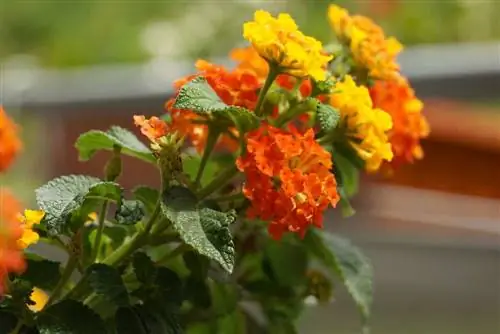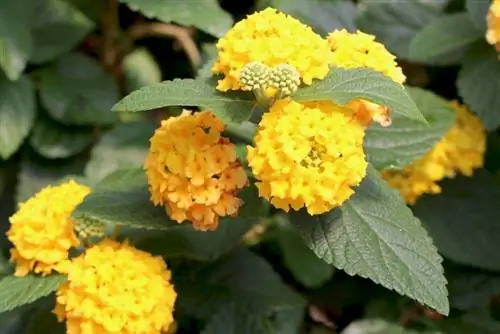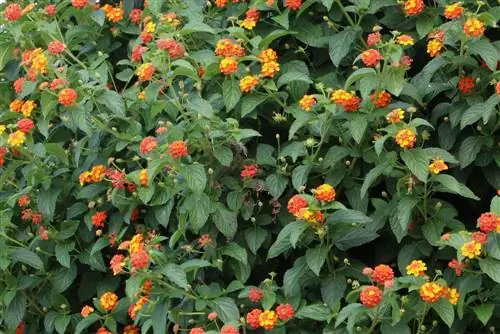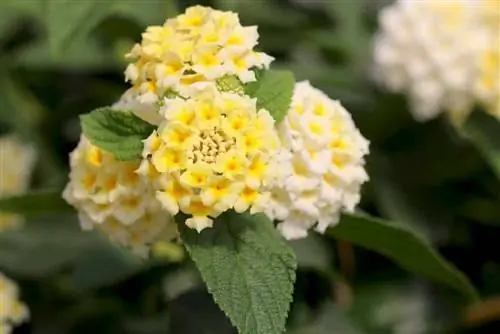- Author admin [email protected].
- Public 2023-12-17 03:39.
- Last modified 2025-01-24 12:45.
The Lantana camara belongs to the verbena family and is still a very popular ornamental plant today. The approximately 150 species come from Central America and southern North America. The flowers are yellow to orange, sometimes white and later often turn reddish to purple. The flower color of the umbels, which changes over time, gives the plant its characteristic colorful appearance and its name.
All parts of the plant are poisonous, especially its drupes.
The wintering quarters
The lantana is not difficult to overwinter if you have the appropriate wintering quarters and pay attention to a few things. During the winter, the lantana usually loses almost all or even all of its leaves and looks pretty pitiful. But that's pretty normal. In spring the plant usually sprouts again well.
- The lantana must be put away before the first frost!
- The location must be bright and cool! - Temperatures between 5 and 10 ˚C are ideal.
- Cool stairwells, winter cold houses in the garden or on the terrace and similar quarters are well suited.
- From February/March the plant is warmed up again.
- First, the shoots are shortened by about a third or even half.
- Very little is poured.
- The cooler the wintering quarters, the less water is required.
- When the leaves are gone, water no longer evaporates and so hardly any is needed.
- Without leaves, the lantana can also overwinter in a dark place, for example in a cool cellar. At the end of February, make it bright and warm again!
- Do not fertilize, only start when the new growth has formed proper leaves!
Care errors
- Too much irrigation water is absolutely harmful. The soil must be completely dry before watering again.
- Too much water is definitely more damaging than too little.
- Pruning too late delays flowering.
- Without pruning there are hardly any flowers.
Editor’s Tips
- Whiteflies, but also other pests, often appear in winter quarters. They can be de alt with using soap and white oil products. It is important to check regularly for pest infestation.
- Shoots that have formed during overwintering are cut away in spring. They are weak and hardly produce any flowers.
- Only put it back outside after the Ice Saints!
The wintering
The attractive ornamental evergreen plant is quite sensitive and does not like cold. Even a slight hint of frost means the leaves and shoots are dying. It could no longer be saved. That's why the lantana must be brought to its winter quarters before the first winter freezing temperatures.
This can be a frost-free greenhouse, a cool windowsill or a bright winter garden. For ideal conditions for overwintering, it must be bright, dry and sunny. The small bush prefers temperatures around 10 degrees Celsius, but 5 degrees Celsius is also appropriate. However, they should be the exception because the tropical plant cannot tolerate any more cold. The low temperatures prevent strong growth and promote hibernation.
If the lantana sheds its leaves, there is no cause for concern. It can now be left in a dark room over the winter because it no longer needs light. However, the root ball must not dry out. If the lantana was planted in the garden or on the balcony during the summer months, it must now be cut out of the soil with a sufficiently large root ball and potted in a planter that is not too small. You may be able to add some potting soil to cover the root ball.
It is useful to shorten the shoots by about a third before hibernation. But carefully tying the branches together is another option. This prevents strong evaporation through the leaves. The lantana still needs to be watered, but only moderately. It does not tolerate waterlogging, but it should not dry out either. Fertilizer can be dispensed with during this time. Winter rest is complete from February to March. New sprouts will soon emerge from the bare, unsightly and overwintered plant. It should now be moved back to a bright, warm location.
Pruning again is important so that the lantana produces many flowers on the newly growing shoots. This is not the case on older shoots. Once the plant has new and beautifully formed shoots, it can be watered and fertilized normally again.

As an evergreen, tropical plant, the lantana naturally does not need a break in the winter. In a heated living room or flower window it will bloom even in the winter months. Then it also requires normal water and fertilizer. Unfortunately, lantanas that do not overwinter in a cool place are more susceptible to pests in the summer months.
The most important things about wintering
- Before the first frost, move the plant to a cool, light or dark winter quarters.
- don't water much anymore, but don't water too little either.
- The root ball must not dry out.
- Avoid fertilizer.
- Short shoots before winter dormancy.
- From February to March, move it back to a warmer and brighter place.
Conclusion
The lantanas are a great floral decoration for rooms, balconies, terraces or gardens. If it is planted in the border or in a bed, it is an advantage if some bark mulch is placed around the root area. This keeps the soil moist longer and protects it from drying out. In the pot, the effect is achieved by planting underneath. Low summer flowers are suitable for this, such as the deep blue Mannestreu. Be sure to remove the dead flowers regularly, because that is the power of the plant.
The lantana also attracts many butterflies with its beautiful flowers and is a constantly blooming, robust and long-lasting classic that is just coming back into fashion.
Temperatures and pruning
- It should be bright and dry for optimal winter conditions
- The lantana prefers temperatures of around ten degrees, but up to five degrees is also acceptable. However, it shouldn't get any colder for the tropical plant.
- You can cut the plant back a little for overwintering. This is useful, for example, if you want to save some space. But carefully tying the branches together is also a way to give the lantana a compact shape.
Normally the plant does not need a rest period and, as an evergreen plant, depends on a bright location. However, if you place it in a dark room, such as a basement, where the temperature is five to ten degrees, it will usually survive the winter without any damage.
Brightness and watering
- In a dark location, however, the lantana behaves as if it were in a dormant phase and sheds all of its leaves. This is not uncommon during wintering.
- regardless of whether the lantana is in light or dark conditions: it still needs to be watered, even if only moderately. It shouldn't get wet, but it shouldn't dry out either.
- you should avoid fertilizing altogether.
By spring only the skeleton will remain. A little later, when the plant is moved to a warmer and brighter location, the branches should sprout again quickly. As soon as the first buds appear, the branches can be cut back a bit. About half to a third can remain. This is important so that the plant blooms vigorously. Older shoots produce fewer and fewer flowers over time. Once the new shoots have formed, you can water and fertilize the plant normally again. The plant should be as bright and warm as possible at the beginning of February so that it sprouts vigorously.






